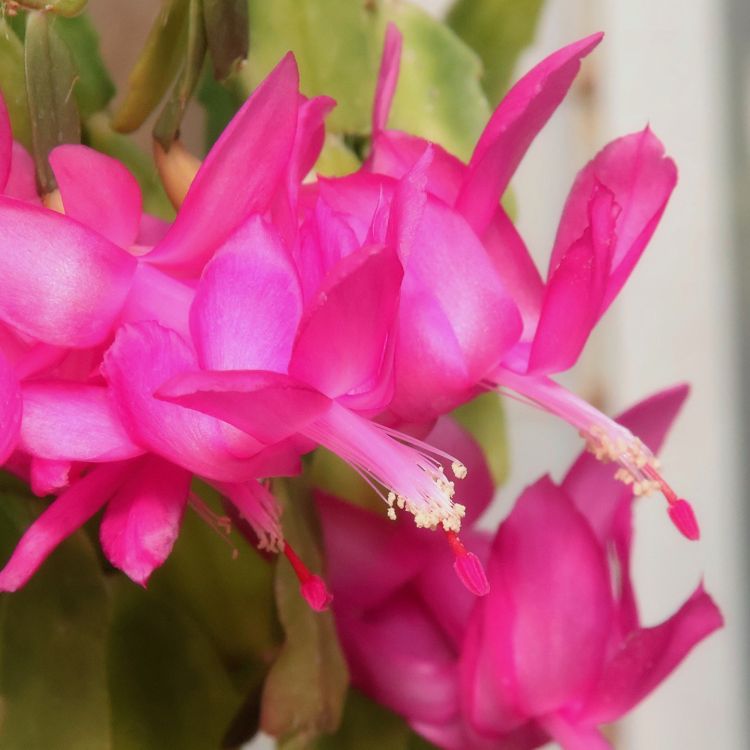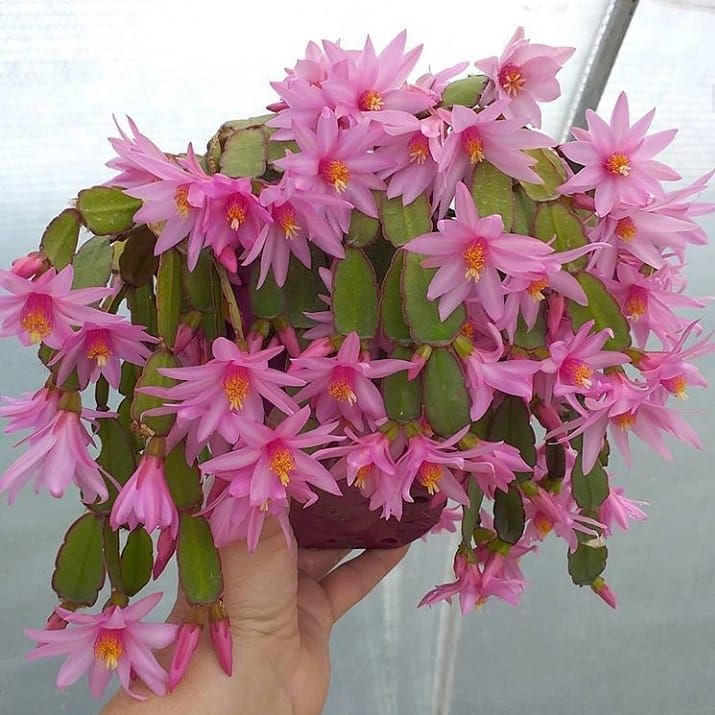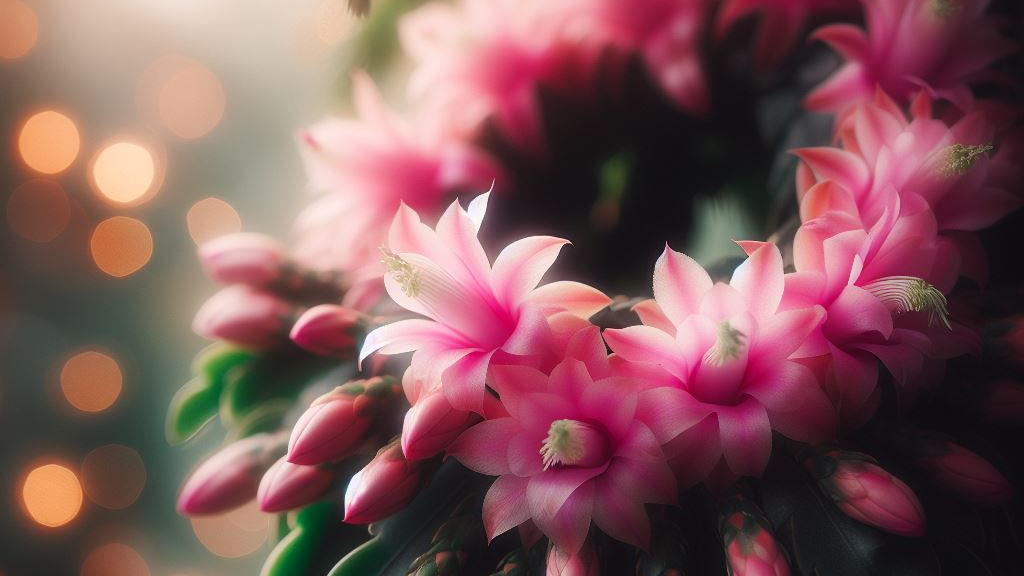In the world of indoor gardening, few plants captivate with their stunning beauty and seasonal charm like the Christmas and Easter cactus. These botanical marvels, native to the tropical rainforests of Brazil, have become cherished staples in many homes, gracing living rooms and office spaces alike with their vibrant blooms and distinctive foliage. Despite their names, these cacti are not your typical desert-dwelling succulents but instead thrive in the filtered light and humid conditions of their native habitat. Let’s delve into the fascinating world of Christmas and Easter cacti, exploring their unique characteristics, care requirements, and the joy they bring during the festive seasons.
Contents
- 1 What’s a Christmas Cactus?
- 2 What is an Easter Cactus?
- 3 Distinguishing Between Christmas and Easter Cactus
- 4 Caring for Christmas and Easter Cactus
- 5 Festive Symbolism and Joyful Traditions:
- 6 FAQs
- 7 Magic of Christmas and Easter Cactus
- 8 Author
What’s a Christmas Cactus?

Image credit:#higetch5405
The Christmas cactus, also known as Schlumbergera bridgesii, stands out among cacti families for its vibrant pink flowers that bloom indoors during the Christmas season in the Northern Hemisphere. Originating from the coastal mountains of southeastern Brazil, this cactus comes in various species, with six to nine of them in total. These cacti are sometimes called Thanksgiving cacti, crab cacti, or holiday cacti depending on where they bloom. Interestingly, in Brazil, where they bloom in May, they’re known as “Flor de Maio” or May flower.
Unlike typical desert cacti, Christmas cacti prefer shady and humid environments, often growing on trees or rocks. Most species have areoles at the joints and tips of their stems, giving rise to flowers that resemble fused leaf-like pads. While some species have cylindrical stems, others exhibit a more distinctive appearance.
What is an Easter Cactus?

Image credit:#cactus._world
The Easter cactus, also referred to as Hatiora gaertneri, is a widely recognized cactus renowned for its striking red blooms that typically appear around the Easter season in the Northern Hemisphere. Distinguished by its spineless nature, this cactus grows in a drooping, branching pattern. Its segmented stems, known as flattened cladodes, lack traditional leaves and feature edges with distinct notches. The vibrant, funnel-shaped flowers commonly emerge near the tips of these segments. To encourage optimal flowering, the Easter cactus necessitates
a period of cooler temperatures during the winter season.
Distinguishing Between Christmas and Easter Cactus
Certainly! While the Christmas and Easter cactus share some similarities, they also have distinct characteristics that set them apart:
Flowering Time
Christmas Cactus
- As the name suggests, the Christmas cactus typically blooms in late fall to early winter, around the time of Christmas in the Northern Hemisphere.
Easter Cactus
- Conversely, the Easter cactus blooms in spring, usually around Easter in the Northern Hemisphere.
Leaf Structure:
Christmas Cactus
- The segments of the Christmas cactus have rounded edges, resembling crab claws or Christmas cacti.
Easter Cactus
- The segments of the Easter cactus have more pronounced, toothed edges, giving it a slightly rugged appearance.
Stem Shape
Christmas Cactus
- The stems of the Christmas cactus tend to be more cylindrical.
Easter Cactus
- The Easter cactus often grows in a more pendulous, branching manner, with flattened, segmented stems.
Blooms
Christmas Cactus
- The flowers of the Christmas cactus are tubular and found in shades of red, pink, purple, or white.
Easter Cactus
- The flowers of the Easter cactus are multiple-petaled and funnel-shaped, usually in vivid red hues.
Growing Conditions
- Both cacti prefer bright, indirect light and moderate humidity, but they have slightly different temperature preferences. While they both grow in moderately warm conditions, the Easter cactus may require cooler temperatures during its dormancy period to encourage flowering.
Cultural Significance
Christmas Cactus
- The Christmas cactus is often associated with the festive season, symbolizing joy, renewal, and the spirit of Christmas.
Easter Cactus
- The Easter cactus is linked to the Easter holiday, representing rebirth, growth, and the arrival of spring.
Overall, while these cacti belong to the same family and share similar care requirements, their distinct flowering times, leaf structures, stem shapes, and cultural symbolism make each species unique and worthy of appreciation in its own right.
Caring for Christmas and Easter Cactus
Despite their exotic origins, Christmas and Easter cactus are relatively easy to care for, making them popular for novice and experienced plant enthusiasts. Here are some essential care tips to ensure the health and vitality of Christmas and Easter cactus.
Light
Christmas and Easter cacti grow in bright and indirect light. Place the plants near a window so they receive filtered sunlight. Direct sunlight, especially during the hottest part of the day, can be too intense and may scorch their delicate foliage. It’s best to provide them with gentle, indirect sunlight to promote healthy growth and flowering.
Temperature
Maintaining a moderately warm environment is crucial for the health of Christmas and Easter cacti. Ideally, temperatures should be kept between 18-24°C. Sudden temperature changes and drafts can stress the plants, so it’s essential to avoid placing them near drafty windows or heating vents. Consistent temperatures within this range provide optimal conditions for growth and flowering.
Watering
While it’s important to water Christmas and Easter cacti thoroughly, it’s equally vital to allow the soil to dry completely between waterings. Overwatering can lead to root rot, a common issue that can harm the plants. By striking a balance and watering only when the soil is dry, you can prevent waterlogged conditions and lead to healthy root development.
Humidity
Maintaining moderate humidity levels is especially important during winter when indoor heating can dry out the air. For the humidity around the plants, you can put a tray full of water and pebbles beneath the pots. As water evaporates, a more humid microclimate is created near the plants. Anyhow, using a humidifier can help to maintain adequate humidity levels, especially in dry indoor environments.
Fertilization
Christmas and Easter cacti benefit from regular fertilization during the growing season, which typically occurs in spring and summer. Use a well-balanced, water-soluble fertilizer diluted to half strength and apply it every 4-6 weeks. Avoid fertilizing during the fall and winter when the plants are resting and not actively growing. Fertilizing during the growing season provides the plants with essential nutrients to support healthy foliage and vibrant blooms.
Festive Symbolism and Joyful Traditions:
Beyond their ornamental value, Christmas and Easter cacti hold symbolic significance for many people, embodying the spirit of the holidays they are named after. During the festive seasons, these resilient plants serve as cheerful reminders of joy, renewal, and the beauty of nature’s cycles. In addition to their symbolic importance, Christmas and Easter cactus have inspired various traditions and cultural practices around the world.
From gift-giving and decorating homes to participating in flower shows and botanical exhibitions, enthusiasts celebrate these beloved plants in myriad ways, fostering a sense of community and appreciation for nature’s bounty.
FAQs
What are Christmas and Easter cactus?
Christmas and Easter cactus are species of cactus known for their vibrant blooms and seasonal charm. Despite their names, they are not typical desert cacti but instead thrive in humid environments.
How do I differentiate between Christmas and Easter cactus?
You can distinguish between them based on their flowering times, leaf structures, stem shapes, and cultural significance. Christmas cacti typically bloom in late fall to early winter, while Easter cacti bloom in spring.
What care do Christmas and Easter cactus require?
These cacti thrive in bright, indirect light and moderate humidity. They prefer temperatures between 65-75°F (18-24°C) and should be watered thoroughly but allowed to dry out between waterings. Fertilize them during the growing season and avoid direct sunlight.
What are some common issues with Christmas and Easter cactus?
Overwatering and underwatering are common issues, leading to root rot or dehydration. Additionally, inadequate light or sudden temperature fluctuations can stress the plants. Proper care and attention to their needs can help prevent these issues.
How do I encourage blooming in Christmas and Easter cactus?
To encourage blooming, provide the cacti with the appropriate amount of darkness and cooler temperatures during their respective dormancy periods. Additionally, ensure they receive proper light, humidity, and fertilizer during the growing season.
Magic of Christmas and Easter Cactus
As we’ve journeyed through the enchanting realm of Christmas and Easter cactus, we’ve gained a deeper appreciation for these remarkable plants and the joy they bring into our lives. Whether adorning our homes with their vibrant blooms, symbolizing the spirit of the holidays, or connecting us to traditions old and new, these botanical treasures continue to enchant and inspire us year after year. So let us celebrate the beauty of Christmas and Easter cactus and cherish the wonder of nature’s creations.

